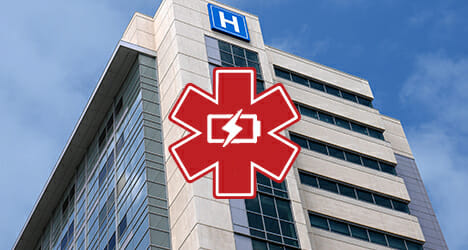Blymyer Engineers designs emergency generator systems for hospitals and acute care centers in California. These systems provide a critical safety net by enabling hospitals to operate without receiving power from the electric grid. The top goal in designing backup generation systems is reliability in the event of a power outage, with fuel supply an essential element. A generator system for a large hospital requires the safe, reliable storage of thousands of gallons of fuel or a stable supply of natural gas.
“Emergency generator systems must be able to deliver power no matter the circumstances,” says Bjorn Enstrom, an engineer and project manager with Blymyer. “Lives are at stake if a healthcare facility lacks power for even a few minutes. Standards for designing emergency generator systems are high, and they should be. Blymyer has the licensing, registration, and experience these mission critical systems requires.”
Meeting OSHPD standards for generator systems
California, with its risk of earthquakes and history of high building standards, has some of the most demanding requirements for emergency generator systems in the United States. A state agency, OSHPD (Office of Statewide Health Planning and Development) oversees the critical work of ensuring compliance with California standards for emergency generator systems for hospitals in California.
The core emergency power system components include a diesel-driven generator and fuel storage, including day tanks and the main storage tanks. The main tanks can be either underground or above ground. Reliability is central to OSHPD standards, which cover everything from redundancy and maintenance to seismic standards.
Designs account for many factors
Here are just a few of the elements that Blymyer factors into designing emergency generator systems for hospitals and acute care:
- Location: Systems need to be placed in such a way as to minimize noise and hazards for the rest of the facility while also ensuring maintenance accessibility and airflow
- Security: Equipment must to be protected so that it can’t be tampered with, and to eliminate the risk that someone might inadvertently bring or leave flammable materials near the system
- Spill protection: Storage tanks may require secondary containment systems
- Fuel requirements: Every hospital and acute care facility has a mandated minimum fuel supply; for instance, some facilities must have enough fuel for a minimum of 72 hours of full demand
- Fuel supply piping: The lines that supply generators have to be fire safe and resistant to earthquake damage, which requires that we engineer them with sufficient flexibility
Fuel system key to reliability and safety
While every healthcare facility must meet OSHPD standards for power generation, no two facilities are exactly alike. Blymyer President Mike Rantz notes, “From a perspective of reliability and overall safety, the fuel system can be one of the most challenging aspects of emergency power generation. We can help you make informed choices when it comes to equipment, above or below-ground storage, and more.”
